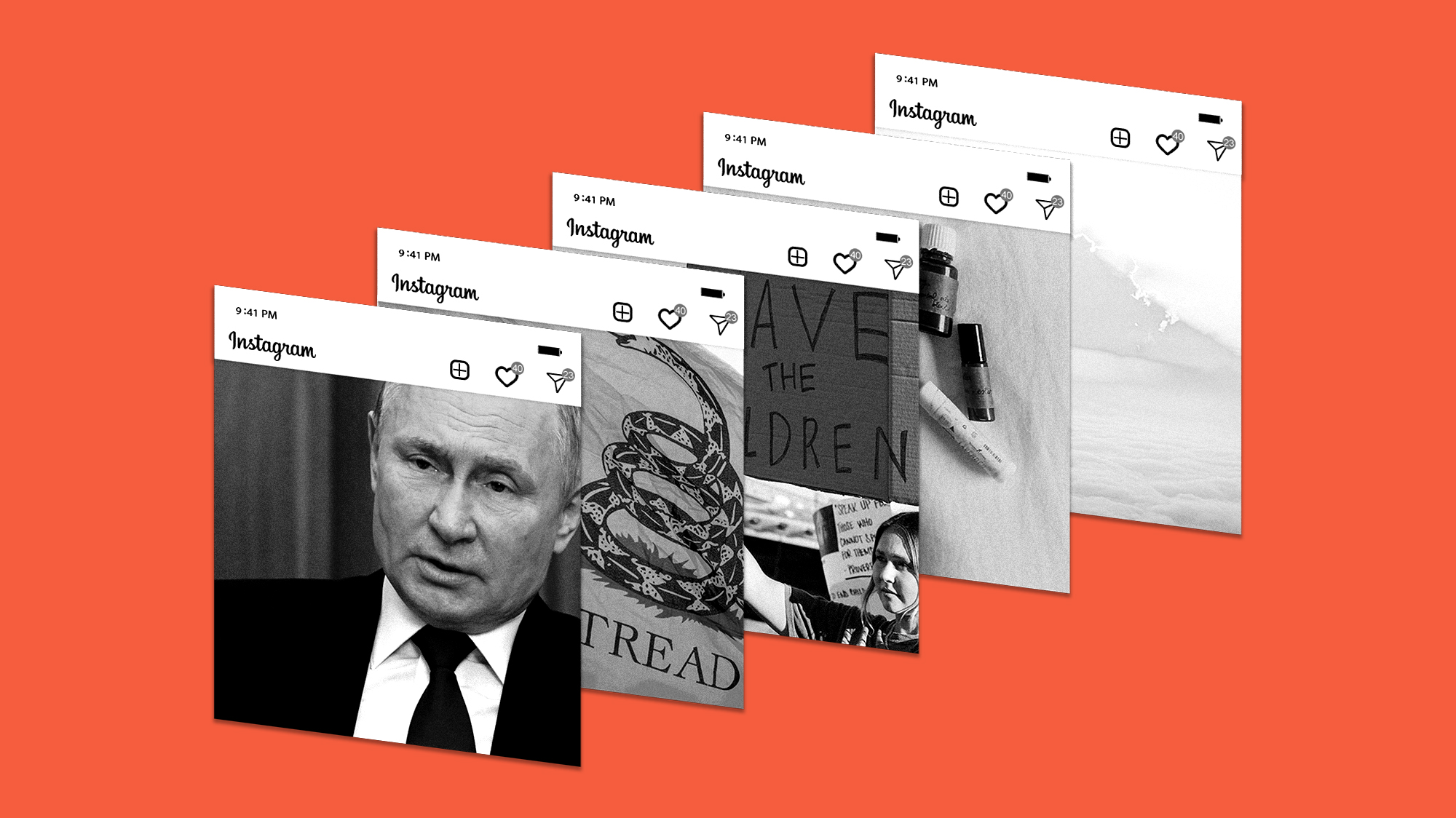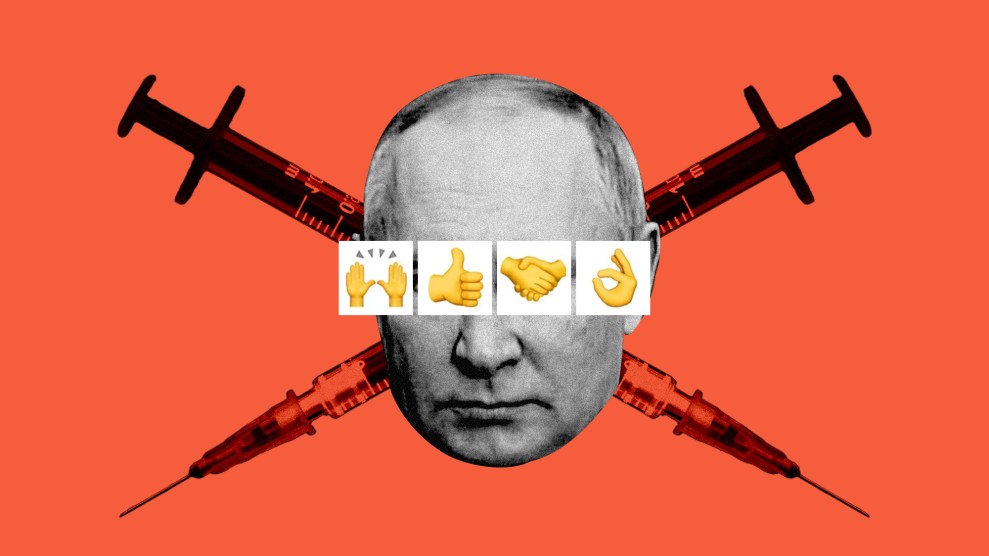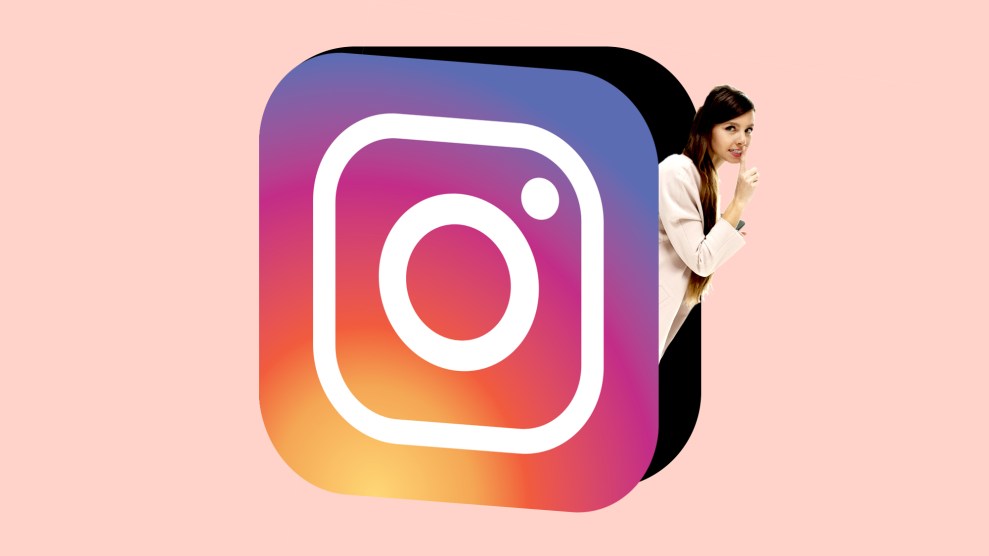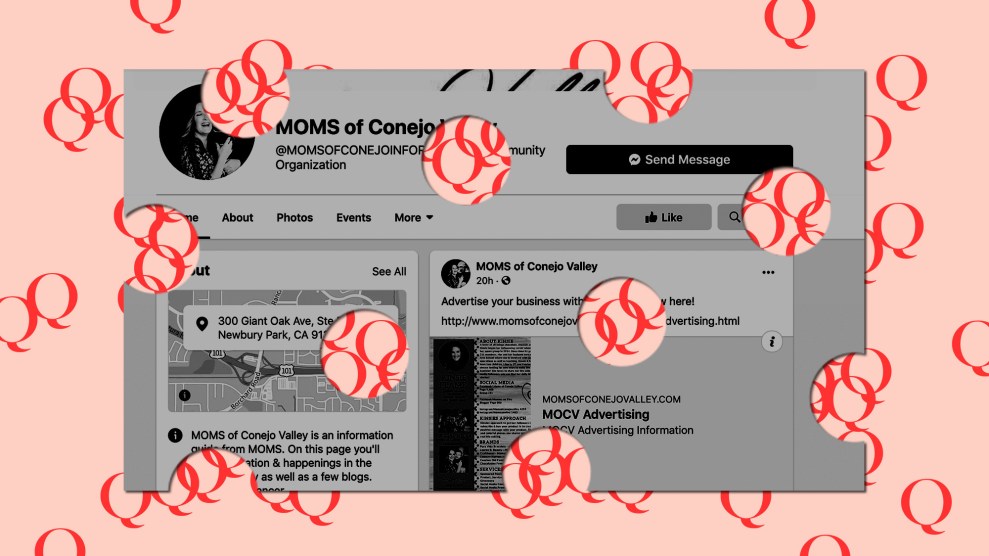Until a few weeks ago, the Instagram influencer Kimberly Lynn had rarely dabbled in international affairs. With her long fuchsia and magenta dyed hair pulled up into a bun, she regularly updated her 20,000 followers about her home renovations, natural cleaning products, and why she chose to have her fourth baby at home. In her profile bio, she described herself as a “7 figure earner helping families create financial freedom.” Sure, she was political, but mostly she was about championing the right in the culture wars, posting memes about the dangers of vaccines (“I identify as someone who doesn’t participate in medical experiments”) and the importance of traditional gender roles (“I am ready for the alpha male variant to return.”)
In late February, though, Lynn suddenly began posting frequently about Russia and Ukraine, expressing sadness and anger about the invasion and fear for her Ukrainian relatives. “I don’t know who needs to hear this, but Putin is not a white hat,” she wrote, using a term for a savior popular among some adherents to the QAnon conspiracy theory. In the comments, her followers pushed back. “I’m not saying he is…but how do we actually know he isn’t?” one wrote. “He is not a white hat but he is standing in the way of the global reset,” responded another, referring to a conspiracy theory about world governments’ plan to fully control citizens. Someone else added, “What do you think of Zelensky? People are fawning all over him like he is some sort of hero…isn’t he corrupt too?”
It was clear that in criticizing Putin, Kimberly Lynn had surprised some of her followers who dwell in a part of the internet where he’s quickly becoming a far-right conspiracy theory folk hero.
In the weeks since I first reported on pro-Putin propaganda in anti-vaccine groups, the overlap between these two spheres has only grown. Last week, the Toronto Star reported a startling correlation between vaccination status and beliefs about Russia’s invasion of Ukraine. More than 80 percent of vaccinated Canadians said they believed their country should help defend Ukraine, compared to less than a quarter of unvaccinated people. This dynamic is especially pronounced in extremist spaces. Some of the anti-mandate trucker convoy chats on Telegram now seem dominated by Putin cheerleading. “The US truck convoy Telegram channels are basically Russian propaganda channels now,” University of Maryland extremism scholar Caroline Orr Bueno observed on Twitter last week. “They’re sharing blatant Russian disinformation about bioweapons in Ukraine and Zelensky being a Nazi, plus content straight from the Kremlin and Russian state media.”
There is not a huge gap in the ideological differences between the far right and the truckers in convoys. But increasingly these geopolitical conspiracy theories have moved beyond extremist spaces and into the mainstream, as polished Instagram wellness influencers cheerfully share them far and wide.
The path of disinformation follows a clear pattern. It starts in the shadows of the internet, where crusaders share some conspiracy with their die-hard followers. But these communities are not locked rooms—rather, people with overlapping interests flow in and out, grabbing pieces of disinformation that align with their own interests and then spreading it to their followers, who in turn do the same. In the last few weeks, I’ve watched this happen in real time, as natural-living Instagram accounts turn wild theories about US-supported biolabs in Ukraine into pastel-hued memes. At first glance, populist geopolitics seems like an odd fit in these accounts. In one post, they might warn about the dangers of cell phone radiation; in the next, they’re suggesting that Putin is ridding Ukraine of pedophiles.
But there is a clear thread here. Rachel Moran, a postdoctoral fellow at the University of Washington’s Center for an Informed Public, has been studying how Instagram wellness influencers use their platforms to spread vaccine disinformation to a largely female audience, folding in friendly messages about girl power and self-care. She has noted how the accounts she follows tend to fold the latest headlines into a grand narrative about the nefarious deeds of government. “It’s incredible how networked these conspiracy theories are,” she said. “Once you’re involved in one of the buckets of misinformation, your likelihood to believe in others is far, far amplified.”
To understand how influencers assimilate new disinformation, let’s take a closer look at the Instagram account @theshinedontstop (tagline: “My rabbit holes are DEEP”). To more than 73,000 followers, a woman who calls herself Chanda posts mostly about health, wellness, and the products she sells: Here’s an essential oils blend to cure your cough! There’s a discount code for a little box to protect you from the electromagnetic radiation in your house!
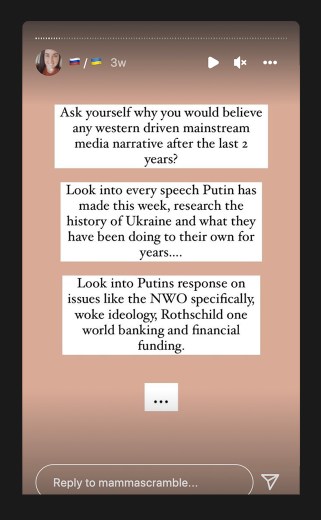
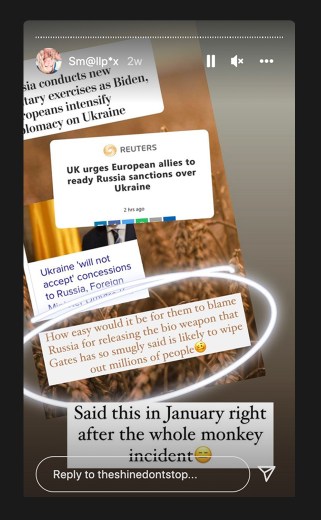
But sometimes, the posts become a bit stranger. Last November, Chanda started a story titled “Sm@llp*x,” which warned that the government could soon create a new pandemic by releasing the deadly smallpox virus. “I have a lot of smallpox tinctures that I made last year,” she wrote on a slide with a photo of a carnivorous pitcher plant that she says can cure smallpox. “I’m still debating if I’m going to hold on to them or sell them but I will for sure do a tutorial for you guys so you can make it yourselves.” She then ratcheted up the weirdness and suggested that government officials might hide smallpox in Covid vaccines. “I’m thinking about the v. and how easy it would be for them to put the SP bioweapon in there and activate it whenever they want.” Subsequent slides painted a picture of a vast bioweapon conspiracy designed to line the pockets of billionaires. Smallpox vaccine prices were rising; Bill Gates was raking in smallpox research dollars; the government was dropping hints about the coming infusion of smallpox money in the new James Bond movie and the cartoon show “Boss Baby.” The implication: The government and their mad scientist henchmen were planning to unleash smallpox on the public, then get rich off the treatments and vaccines.
That’s where Chanda’s musings ended—until late February, that is, when she began to add new slides to her story. “Russia is the only other place other than the US to house the smallpox virus AND the CIA and DOD found SEVERAL biolabs in the Ukraine,” she wrote, referring to the disproven theory that the United States is defending Ukraine in order to protect its top-secret infectious disease research there. “How easy would it be for them to blame Russia for releasing the bioweapon that Gates has so smugly said is likely to wipe out millions of people.”
To recap: I clicked on a story about smallpox, and somehow ended up at biolabs in Ukraine. That progression was probably no accident. Since Instagram allows users to add to stories whenever they want, they’re perfect for folding new ideas into a grand narrative. Even better, notes Moran, they’re hard to police, because they’re image-based and largely unsearchable by disinformation algorithms. For this reason, influencers often “post normy content on their grid, and then post the good stuff in the stories.” I asked Moran if she thought Meta’s fact-checkers should be more closely monitoring stories for disinformation. “It would take hours and hours every day,” she said. “The amount of content, generally, is insane.”
Of course, the time it takes to consume all that content pales in comparison to the hours that influencers devote to actually making it. So, what’s in it for them? Most likely, they’re not being paid directly by Russian operatives—the dynamic is much more complicated than that, says George Washington University disinformation researcher David Broniatowski. In a 2018 study published in the American Journal of Public Health, Broniatowski’s team documented how Russian operatives sought to polarize Americans on the issue of vaccines by posting controversial statements on social media. This campaign wasn’t intended to change people’s minds about vaccines; rather it was to sow discord. Broniatowski’s team found that the same accounts were equally likely to endorse vaccines as they were to criticize them. “Finding an issue that they thought people could fight about, and then encouraging people to fight about it,” had the salutary result of further dividing the country into ideological camps.
Over the next several years, as the pandemic set in, those divisions intensified and metastasized. As I documented, factions of anti-vaccine groups increasingly embraced Covid denialism and dabbled in QAnon. The Russians’ initial plan of dividing Americans had worked better than they could have possibly expected—so that by the time Russia invaded Ukraine earlier this year, anti-vaccine activists were primed to believe that Putin was the good guy. As for Biden? His administration was trying to pull a fast one on them by painting Russia as the aggressor. Should social media platforms flag influencers’ content as disinformation, it only serves to reinforce their belief that they are being punished for their righteous truth-telling.
Some influencers have monetized their self-proclaimed martyrdom by sharing disinformation about Ukraine and hawking their own wellness items. Moran notes, “They say, ‘I’ve got a plethora of opportunities for you to financially support this person and then get a product in return.’” For example, the influencer behind the account @mamascramble, whose bio says she is an “entrepreneur,” intersperses her posts about politics with plugs for the essential oils and other products she sells. In early March, she posted a story about Ukraine. “Look into every speech Putin has made this week, research the history of Ukraine and what they have been doing to their own for years,” she wrote. She urged followers to “look into Putin’s response” on “woke ideology and Rothschild one world banking,” referring to an old anti-Semitic conspiracy theory about Jewish control of world finances—one that was current even before World War II. After that story ends, followers are pulled into the following space, where she flogs her “wellness boxes,” which are full of “patriot-owned, USA-made products.”
Beyond the oils and the tinctures, influencers are selling something much more valuable: a sense of fierce and uncompromising maternal identity. The account bios frequently mention natural childbirth, breastfeeding, and attachment parenting—and their posts and stories tie events in Ukraine back to defending their families from what they see as government overreach. The Canadian influencer behind the account @theholisticvanity, who describes herself as a “home-birthing and extended breastfeeding mama of two,” recently posted slides from other accounts that strained the bounds of logic in connecting Ukraine back to vaccine and mask mandates. “It is not okay to use the war in Ukraine to continue your assault on anti-mandate protesters,” reads one. Another says, “I am well aware that some people have switched from racism to the invasion of Ukraine to try and make us feel bad for protesting against mandates.”
Another Instagram user took an even more cryptic approach in a recent story. @Echounafraid has 108,000 followers and a bio reading “Wife. Mom. Doula.” In a story from early March titled “Current Events,” she never mentions Ukraine or Russia explicitly. Instead, she makes vague allusions to the conflict and then changes the subject—first to vaccine mandates, then to the parents’ rights movement. “Lots of people talking about the agenda behind this newest crisis,” she writes. “MANY wonderful, thoughtful, critical thinking humans LOST THEIR JOBS or were forced to quit (because of an inevitable ultimatum).” Then, at the end of the story, she suddenly switches topics, showing a photo of an Idaho baby taken out of his parents’ custody because they were withholding lifesaving medical treatment. “There is a WAR happening in regards to parents’ rights,” she writes. Just to take inventory: In a single story, she’s touched on Ukraine, vaccine mandates, and the powerful idea that the government is trying to control families by literally removing children from their parents.
One central question, however, is if the ascendant parents’ rights groups will broadly embrace disinformation about Ukraine. It’s probably too soon to say—but the possibility is certainly not out of the question. Last week, Mother Jones’ Ali Breland wrote about the extremist groups who are trying to convince mainstream Republicans that Putin’s invasion is justified. “To date, the American right has not firmly settled on a unified position on the invasion,” Breland wrote. “Speaking out against Ukraine seems unthinkable in the current moment, but large swaths of the contemporary right do not care about boundaries of acceptability established by the center-left and even conservative moderates.”
Broniatowski echoed those sentiments and noted that if this trend continues, the American right’s drift into conspiracy thinking could become a national security liability. “When you start having such a clear indicator of a susceptible population, that population can then get seeded with other conspiracy theories,” says Broniatowski. “And they become a population that can be relatively easily mobilized for other uses.” As disinformation about Ukraine proliferates in seemingly unrelated parts of the internet, one thing is for certain: Russia is watching.
Images from left: Alexei Nikolsky/Kremlin Pool/Planet Pix/Zuma, Ehimetalor Akhere Unuabona/Unsplash, Joel Muniz/Unsplash, Mariana Rascao/Unsplash, Daniele Franchi/Unsplash,
